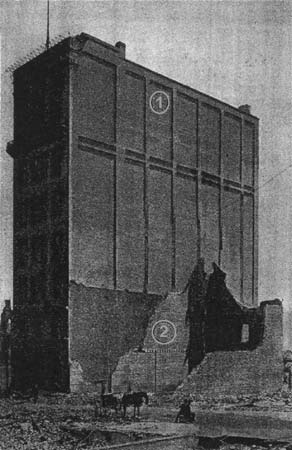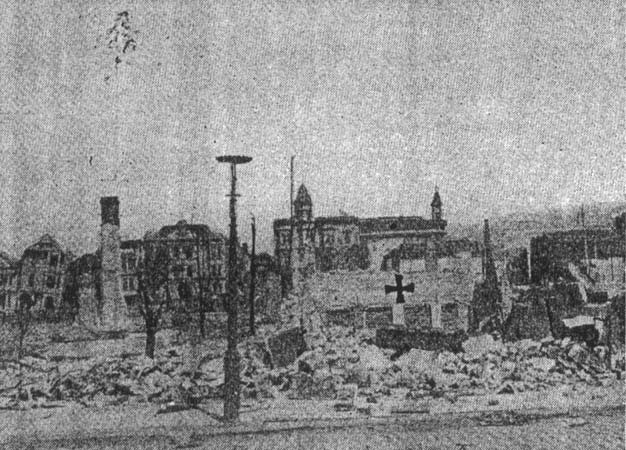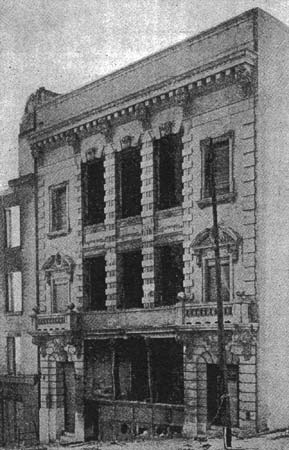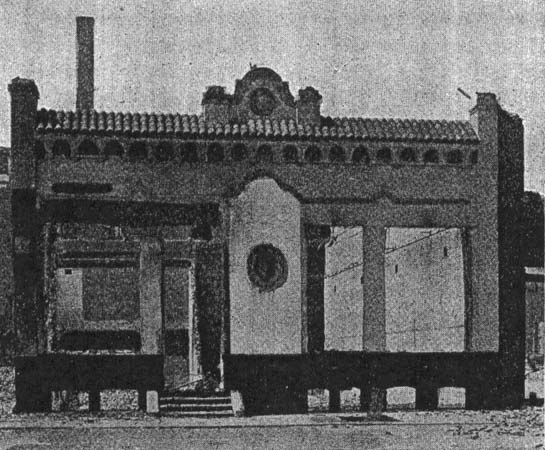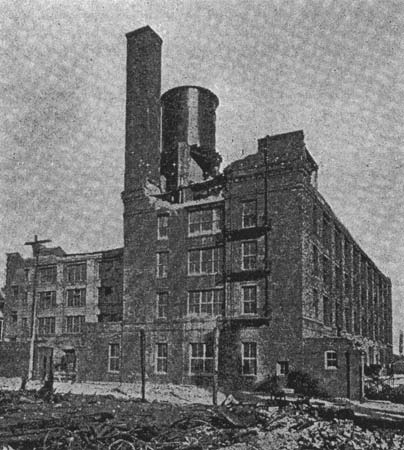[Trade Journal]
Publication: Western Electrician
Chicago, IL, United States
vol. 38, no. 21, p. 415-416, col. 1-3,1
Some San Francisco Episodes.
One of the greatest sufferers by the earthquake and fire of April 18th in San Francisco was the Pacific States Telephone and Telegraph Company. Scarcely one of its exchanges escaped damage, and most of them were destroyed or so badly shaken or burned as to be useless until almost completely rebuilt. The New West Office at Pine and Steiner streets was saved, and is now the headquarters of the company. The main operating building at 216 Bush Street is practically a total ruin. The New Exchange Building was also burned. The New South Office was badly shaken and burned, with the loss of a new switchboard. The Public Office at 154 Geary Street was unroofed and gutted. The Park Office, although injured, was not burned, and is now in operation. The East Office at Hyde and Sutler streets was damaged, but is now used as the bookkeeping headquarters. The Old Mission Office is simply a mass of debris. The Old South Office on Jessie Street was practically destroyed by earthquake, and fire completed the devastation. The accompanying pictures will show the appearance of some of the exchanges after the fire.
| |||
| 1. Temporary Board Installed in This Building. 2. Ruins of New Main Operating Office on Bush Street. Not Harmed by Earthquake, But, With New Switchboard, Destroyed by Fire. Ruined Telephone Exchange in San Francisco. |
San Francisco has long had the reputation of being one of the most advanced cities in the world in the extent and excellence of its telephone service. Before the calamity the operating company had, in round numbers, 50,000 connected subscribers to its service. Today it has 2,200. This is a sad contrast. Possibly 8,000 applications for connections are on file, but in many cases there are no buildings in which to install the telephones. As to the overhead construction, its condition after the fire may be imagined. But the underground cables were in very fair condition, and the whole situation is being gradually cleared. There is no doubt that in the end San Francisco will have as good or better telephone service than before the earthquake; but a prodigious amount of work is in sight before this result shall have been accomplished.
The regular correspondent of the Western Electrician at San Francisco contributes this; Oakland, Cal., May 16. — The Pacific Gas and Electric Company and its subsidiary concerns, the San Francisco Gas and Electric Company and the California Gas and Electric Corporation, are restoring their system in San Francisco and vicinity as rapidly as changed conditions will permit. A large one-story storeroom, with some office accommodations, has been hastily constructed at Fifth and Howard streets, the old Pacific Gas Improvement Company's gasworks site, where a large store-house had been abandoned a few weeks before the fire.
Several weeks ago the San Francisco Gas and Electric Company opened about a dozen sub-offices in various parts of the city, so that lighting bills could be paid and gas stoves ordered without a trip to the main office at 415 Post Street, which was destroyed by the fire. Several of these smaller offices that were outside the burned district have been reopened. E. C. Jones, chief engineer of the gas department, says that the gasworks are now in good enough condition to supply all the gas that is needed in the unburned districts. On the night of May 12th 2,300 gas lamps for street lighting were lighted for the first time since April 17th. This relieved the Stygian gloom that had nightly enveloped. the entire burned district and all but a few streets that had had arc lights for a week before. Several thousand gas connections have since been made to dwelling houses and stores, considerably relieving the cooking situation. Nearly the entire population had been cooking in the streets for more than three weeks.
| |||
| Cross Shows Ruins of Old Mission Office. Total Wreck From Earthquake and Fire. Pile of Debris That Was Once A San Francisco Telephone Exchange. |
Representatives of the San Francisco Gas and Electric Company say that the Jessie Street station between Third and Fourth, which was considerably damaged by the earthquake and more so by the fire, will be rebuilt. Some of the boilers have already had steam up, although the big stack was broken off. Chief Electrician Fitzpatrick fell a vice tim in the performance of duty. He waited long enough to shut off the motor-generators during the shock of April 18th, and on reaching the street was crushed beyond recognition by the falling smokestack. A view showing the broken chimney appeared in the Western Electrician May 5th. Before April 18th work had already progressed far in restoring the new sub-station section of the Jessie Street station that was badly damaged by fire on February 22d. It is asserted that there will be considerable salvage on the three 1.000-kilowatt motor-generator sets that were in operation there at the time of the earthquake. The principal damage to the machinery is said to have been caused by the Scott & Van Arsdale Building falling on the motor-generators, which did not suffer very much from fire. The Eighth and Kansas street sub-station was saved, enabling the current from the Standard Transmission lines to be distributed in the city.
| |||
| Old South Office, Jessie Street, Destroyed by Earthquake and Afterward Burned. Ruined Telephone Exchange in San Francisco. |
The Visitacion Valley plant, where the three 5,000-horsepower gas-engine-driven generating sets were being installed, has been repaired. One of the big engine bed-plates was cracked. The frequency changers and complicated switchboards in connection with this station were put out of commission for several days by the earthquake, but are again in operation, so that the United Railroads can be supplied with current under the 20-year contract that became effective January 1st. This required the California Gas and Electric Corporation to furnish all the current needed for the operation of cars. The United Railroads, however, started up its own generating station at North Beach as soon as it could be repaired after sustaining a severe earthquake damage. The power-line connections to and from Visitacion Valley were broken. The main generating station of the San Francisco Gas and Electric Company in the Potrero district is said to have been undamaged, but it has not been operated to anything approaching its full capacity since the disaster of April 18th. When the Jessie Street station switchboard and connections have been rebuilt and temporary sub-stations installed on the sites of the five that were burned the Potrero plant will again do very effective work.
The Journal of Electricity, Power and Gas for May 12th has made its appearance, without a cover and differing much in appearance from preceding issues. However, it is calmly hopeful. It "feels that it can, with conservatism, report a gratifying condition at the present time in all the interests it represents, and to forecast a steady and permanent upbuilding along lines which insure business security."
Well named "Energy," the house organ of the California Electrical Works of San Francisco — the "Earthquake Edition" — has been issued on time, and is of particular interest. This company is one of the Pacific Coast agents of the Western Electric Company of Chicago, and its well constructed building at 642 Folsom Street is a center of the electrical supply trade of San Francisco. By unremitting labor, this building was saved from the fire with comparatively little injury, and in it work is now proceeding as in the past. Some idea of how it was done may be gained. from the following paragraphs, quoted from "Energy:"
| |||
| East Office at Hyde and Sutter Streets. the Bookkeeping Department of the Pacific States Telephone and Telegraph Company is Now Located in This Building. Damaged Telephone Exchange in San Francisco. |
Through the destruction of a neighboring plant, we were without power and light. A 40-horsepower gasoline engine came by express from Los Angeles, and with generators from our own stock, lowered by means of block and tackle from the fourth floor, supplied us with a temporary plant. It would take pages to describe the difficulties overcome in locating and obtaining this engine in a distant railroad yard in Oakland, its removal to San Francisco and its installation in our building there without handling appliances of any kind. Trucks were obtained, but there were no horses, and men were sent miles into the country to obtain them.
Street-car equipment was destroyed. Automobiles were purchased for use by our city sales department, for the purpose of making emergency deliveries and for the transportation of employes between the office and their temporary homes.
We were without telephone service. Our house system was quickly placed in working order and a temporary line installed to the West Exchange, the only one left standing, giving us a connection with the outside world.
About 150 men were at work and had to be fed and housed. A commissary department was promptly organized to provide for them.
Printing houses were burned out, and a complete printing plant in Oakland was taken over to supply our needs in this direction.
During the height of the fire we filled one order for 150 cells of gravity battery for use of the Fire Alarm Department. The order was written on a paper bag and signed by a total stranger to us without reference to the credit department.
The West Exchange of the Pacific States Telephone and Telegraph Company maintained service for the police, government and fire-alarm departments by the use of a Western Electric charging outfit, operated by a gasoline engine, and erected in a tent in the adjoining street. Connection with the ferry station was made by means of an expensive silk-and-cotton-covered switchboard cable erected on sawhorses in the streets.
| |||
| This Picture Shows A Portion of the Rear Wall, Which Fell at First Earthquake Shock. the Brick Chimney Was Damaged and is Now Being Taken Down. Water Tank, Containing 70,000 Gallons, Was Not Thrown Down. Building of California Electrical Works, Folsom Street, San Francisco, Which Went Through Earthquake and Fire With Only Slight Damage. |
The greatest factor in the saving of our building was wire-glass. One side of the building was a blank wall. In the other side and rear were windows of wire-glass set in metal frames filled with concrete. The fire came from the rear and swept around both sides, where it literally beat and pounded against the glass, but could not find an entrance, and the glass stands today badly cracked, but intact. A prominent contractor who examined our building after the fire states that many buildings could have been saved had this form of construction been used.
The business of the last few days has thoroughly demonstrated that the best salesman is the one that can write the fastest.

